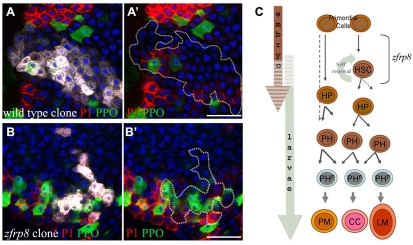Fig. 3.
Lack of Zfrp8 affects HSCs but not prohemocyte pluripotency. (A-B′) Confocal crossections of wild-type (A,A′) and Zfrp8 mutant (B,B′) clones (white in A,B; outlined in A′,B′) encompassing prohemocytes (no marker), plasmatocytes (P1, red) and crystal cells (PPO, green). Scale bars: 20 μm. (C) Hematopoiesis in the Drosophila lymph gland. During embryogenesis primordial cells form hematopoietic stem cells (HSCs) and hemocyte precursors (HP). HSCs undergo an asymmetric division, self renewing and giving rise to HPs, which undergo a number of mitotic divisions, migrate towards cortex and undergo gradual differentiation (Jung et al., 2005; Mandal et al., 2007). We call committed cells at intermediate stages of differentiation prohemocytes (PHs). Advanced PHs (PHP) express the early cortical marker Pxn, and during the third instar larval stage differentiate into plasmatocytes (PM), crystal cells (CC) and lamellocytes (LM). Zfrp8 functions in HSC maintenance.

